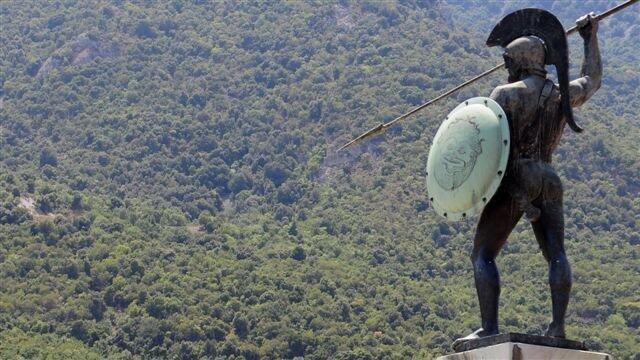The first line of defence at the Vale of Tempe was soon abandoned, driving the Thessalians into the Persian camp. The first battle would be fought in September 480 BC at the strategic location of Thermopylae, where approx. 7,000 hoplites under King Leonidas of Sparta lined up to cut off the enemy's access to the South.
According to the later historian Plutarch, when Xerxes sent heralds asking the Greeks to lay down their arms, Leonidas' response was “Molon Lave”, meaning “Come and take them”. The Persian King was enraged and ordered the attack.
The Greeks, lined up in the straits of Thermopylae, neutralized the numerical advantage of the Persians, who could not even deploy their cavalry. Thus, the first two days of the battle ended with significant Persian losses. According to Herodotus, the enemies’ impasse was resolved by Ephialtes, son of Eurydemos, who revealed to Xerxes a path that would allow the Persians to emerge behind the Greeks and surround them.
Indeed, during the night, select Persian corps crossed the path, pushed back the Phocians who were guarding it and, thus, the morning found the Greek forces surrounded. Most of the Greeks fled, but 300 Spartans, 700 Thespians and 400 Thebans were left to defend Thermopylae.
The conflict was fierce and it was initially fought with spears in an attempt to keep the enemy at bay, but soon swords were drawn and hand-to-hand combat began. The climax was the death of Leonidas, followed by a furious battle around the body of the dead King. Herodotus describes how the Greeks who lost their weapons continued to fight using their hands and teeth.
The Greek forces were not able to prevail. The Persians massacred those who continued to fight and branded with a red-hot iron those who surrendered. Despite the defeat, the Battle of Thermopylae remains one of the most important moments in world military history, due to the courage and self-sacrifice of the Greeks. The epigram of the poet Simonides of Ceos reflects the moral dimension of the conflict: “Go, tell the Spartans, thou who passest by, that here obedient to their laws we lie.”
Main Bibliography
- Bury John – Meiggs Russell, A History of Greece. To the Death of Alexander the Great, Translated by Rouli Tataki, K. N. Petropoulos, Anna Papadimitriou - Grammenou, Konstantinos Buraselis, Angelos Matthaiou, Athens 2011.
- Αλεξάνδρου, μτφρ. Ρούλη Τατάκη, Κ. Ν. Πετρόπουλος, Άννα Παπαδημητρίου Γραμμένου,
- Κωνσταντίνος Μπουραζέλης, Άγγελος Ματθαίου, Αθήνα 2011.
- Lefèvre François, Histoire Du Monde Grec Antique, Translated by Anastasia Kefala, Mina Kardamitsa, Athens 2016.
- Καρδαμίτσα, Αθήνα 2016.
- Antonopoulou Zeta, Τα Γλυπτά της Αθήνας: Υπαίθρια Γλυπτική 1834-2004, Athens 2003.
- Karaiskou Vicky, Νεοελληνική Γλυπτική: Ματιές και αναγνώσεις, Athens 2011.
- Pavlopoulos Dimitris, Ζητήματα Νεοελληνικής Γλυπτικής, Athens 1998.
- Γλυπτά, Αθήνα 2020.
- Pavlopoulos Dimitris, Από τον Ιερό Λόχο στον Κωνσταντίνο ΙΒ’: Νεότερα Αθηναϊκά Γλυπτά, Athens 2020.
Main Webliography
http://www.athenssculptures.com
https://explore.cure-project.gr
https://www.thisiscrete.gr/gr/historical-monuments
https://www.wikipedia.org
Informations




